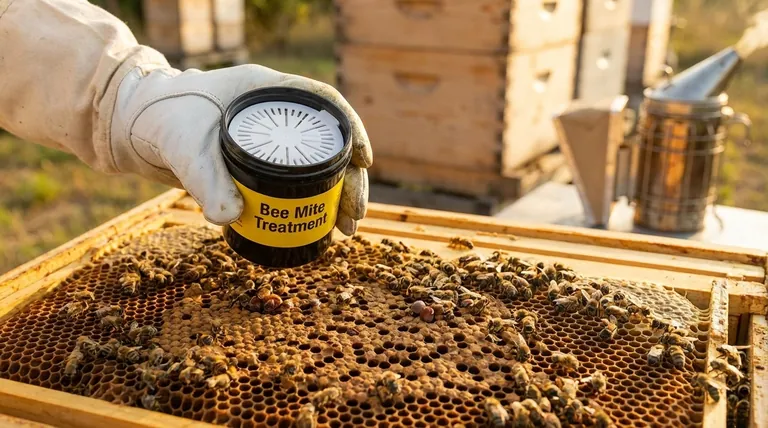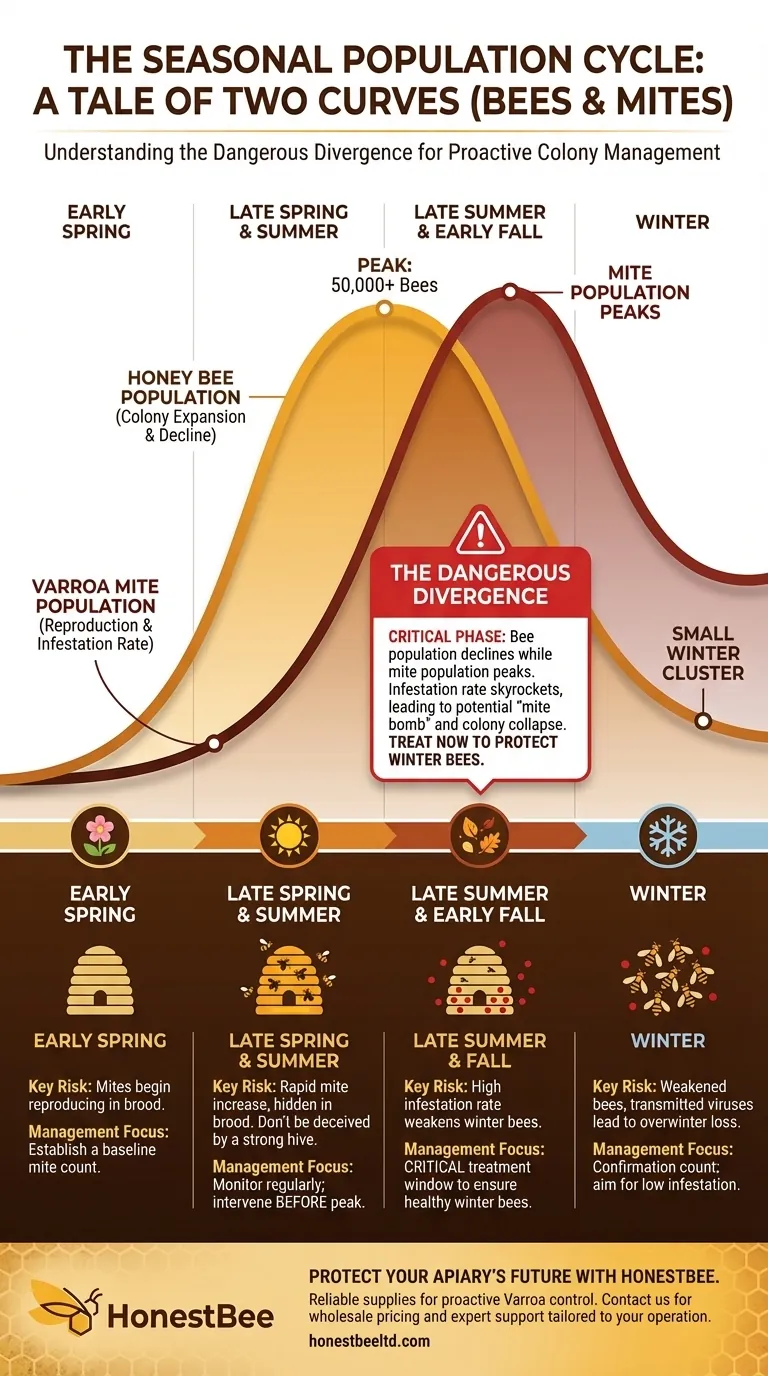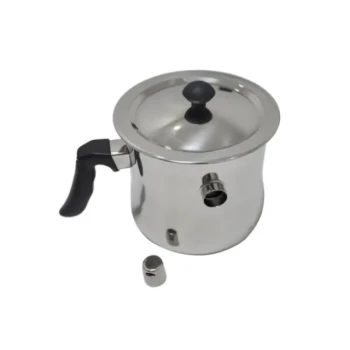In short, Varroa mite populations rise and fall in response to the honey bee population, but with a critical delay. Mite populations build as the bee colony expands through spring and summer. However, the most dangerous period occurs in the fall when the bee population naturally declines, causing the ratio of mites to bees to spike dramatically, which can lead to colony collapse.
The central challenge for beekeepers is not the absolute number of mites, but the infestation rate. This rate becomes critically high in the autumn when the bee population shrinks, leaving the remaining bees to face a concentrated and overwhelming mite load just before winter.

The Seasonal Population Cycle: A Tale of Two Curves
Understanding the relationship between honey bee and Varroa mite populations is best visualized as two interconnected curves that diverge at a critical point in the season. Your goal is to manage the mite curve to prevent it from overwhelming the bee curve.
Early Spring: The Slow Start
As the queen resumes laying and the colony begins its spring buildup, both bee and mite populations are at their lowest points. The mites that survived winter begin to reproduce within the first cycles of sealed honey bee brood.
This is a period of slow, often unnoticed, growth for the mite population.
Late Spring & Summer: The Population Boom
As the landscape blooms, the bee population explodes, potentially growing from 20,000 to over 50,000 bees. This exponential increase in brood provides a massive reproductive engine for Varroa mites.
A larger bee population supports a larger mite population. For instance, a colony with 1,200 mites in the spring can easily see that number climb to 3,000 or more by mid-summer as they reproduce in the expanding brood nest.
While the number of mites increases, the infestation rate (mites per 100 bees) may appear stable or grow slowly, lulling a beekeeper into a false sense of security.
Late Summer & Early Fall: The Dangerous Divergence
This is the most critical phase of the year. The bee colony's population naturally peaks and begins to decline as forage becomes less abundant and the queen reduces her laying rate.
However, the mite population has just reached its own peak. As the bee population shrinks, the now-massive mite population becomes dangerously concentrated.
A mite load that was tolerable for 50,000 bees becomes devastating for the 25,000 bees remaining in the fall. This is when the infestation rate skyrockets, leading to what is often called a "mite bomb."
Winter: The Aftermath
The bees that are born in the fall are the "winter bees" meant to sustain the colony until the following spring. If these bees are weakened by high mite parasitism and the viruses mites transmit, the colony's chance of survival is severely compromised.
A high mite load in the fall is the leading predictor of winter colony loss.
The Deceptive Nature of Mite Infestations
Effective mite management requires understanding the hidden nature of the threat. Relying on visual inspection alone is a common and often fatal mistake.
The Problem with 'Eyeballing' It
The vast majority of Varroa mites (over 80% during brood-rearing season) are hidden from view, reproducing within capped brood cells. Seeing mites on the backs of adult bees is a sign of an extremely severe, late-stage infestation where the colony is already in grave danger.
The Fallacy of a 'Strong' Summer Hive
A large, productive hive in July can easily mask a growing mite problem. The sheer number of bees dilutes the infestation rate, making the colony appear robust and healthy.
This apparent strength is deceptive. Under the surface, the mite population is building to a level that will become unsustainable once the bee population begins its natural autumn decline.
The Consequence of Inaction
Failing to act in the summer and early fall means the winter bees—the most important bees of the year—will be born into a high-mite environment. They will be weakened, have shorter lifespans, and be less capable of maintaining the winter cluster.
This is the direct pathway to colony collapse disorder and overwinter failure. Proactive monitoring is the only way to break this cycle.
Aligning Your Strategy with the Season
Your management strategy must be proactive and timed to the seasonal dynamics of the bee and mite populations.
- If your focus is Early Spring: Your goal is to establish a baseline. Conduct your first mite count of the year to understand your starting point.
- If your focus is Mid-Summer: Do not be fooled by a strong appearance. This is when the mite population is growing exponentially, so regular monitoring is critical to know if you need to intervene before the population peaks.
- If your focus is Late Summer/Early Fall: This is the most crucial treatment window. You must lower the mite load now to ensure your winter bees are healthy and strong.
- If your focus is Pre-Winter: Your goal is confirmation. Perform a final mite count after any treatments to ensure the infestation level is well below the damage threshold before the colony clusters for winter.
Understanding this seasonal dynamic transforms you from a reactive beekeeper to a proactive manager of your colony's health.
Summary Table:
| Season | Honey Bee Population | Varroa Mite Population | Key Risk & Management Focus |
|---|---|---|---|
| Early Spring | Begins to grow | Low, begins reproducing in brood | Establish a baseline mite count. |
| Late Spring & Summer | Peaks (50,000+ bees) | Rapidly increases, hidden in brood | Monitor regularly; don't be deceived by a strong-looking hive. |
| Late Summer & Fall | Declines sharply | Peaks, leading to a high infestation rate | CRITICAL: Treat now to protect winter bees. |
| Winter | Small winter cluster | Weakens bees, transmits viruses | High fall mite load is the leading predictor of winter loss. |
Protect Your Apiary's Future with HONESTBEE
Understanding the mite-bee cycle is the first step; effective management is the next. Don't let a hidden mite bomb decimate your colonies this fall.
HONESTBEE equips commercial apiaries and distributors with the reliable supplies needed for proactive Varroa control. From monitoring tools to effective treatments, our wholesale-focused operations ensure you have what you need, when you need it.
Take control of your seasonal strategy. Let's discuss how our equipment and expertise can help you maintain healthy hives and maximize overwintering success.
Contact HONESTBEE today for wholesale pricing and expert support tailored to your operation.
Visual Guide

Related Products
- Adjustable Formic and Acetic Acid Dispenser for Bee Mite Treatment
- Varroa Easy Check Mite Tester Kit Counter Alcohol Wash Jar
- Economy Galvanized Beekeeping Honey Bee Smoker for Wholesale
- Professional Bee Smoker with Elongated Spout and Durable Bellows for Beekeeping
- Wooden Queen Bee Excluder for Beekeeping
People Also Ask
- What should beekeepers do to manage varroa mites effectively? Adopt a Proactive Monitoring Strategy
- What is the focus of hive management during summer? Maximize Your Honey Harvest with Expert Tips
- What are some common predators and pests that target beehives? Protect Your Hives from Bears, Mites, and Beetles
- How can beekeepers ensure their hives survive the winter? A Guide to Colony Survival
- What should be done after treating a colony for varroa mites? A Step-by-Step Guide to Verifying Success



















